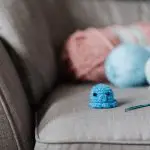When you're looking to achieve that perfect fabric stiffness for your project, it's crucial to understand the various methods and agents available to you. From starch and gelatin to specialized fabric mediums, each option can yield distinct results. You'll find that techniques like dipping, spraying, and brushing can all impact the final texture and durability. However, it's not just about the product; factors like fabric type and environmental conditions play a significant role too. So, how do you determine the best approach for your specific needs?
Table of Contents
Key Takeaways
- Various fabric stiffening agents, like starch, gelatin, and fabric medium, offer different properties suitable for specific projects.
- Spray stiffeners provide quick application; test on scrap fabric first to ensure the desired result.
- Dipping, brushing, or spraying starch solutions can effectively control the stiffness of the fabric.
- Glue-based methods require even distribution and sectional work for precise application and strong bonding.
Types of Fabric Stiffening Agents
When it comes to fabric stiffening, you'll find a variety of agents that can help you achieve the desired firmness and structure.
One popular option is starch, which can be found in both liquid and powdered forms. It's easy to use; just mix it with water and apply it to your fabric. As it dries, you'll notice how it adds body and shape.
Another effective agent is gelatin. Often used in more delicate fabrics, it provides a softer hold while still offering some stiffness. You can dissolve it in warm water and apply it directly to your fabric for a subtle finish.
For those looking for a more permanent solution, consider using fabric medium. This acrylic-based agent not only stiffens but also helps maintain the fabric's flexibility, making it ideal for crafts and artwork.
If you're after something eco-friendly, try using corn syrup mixed with water. This natural alternative can give your fabric a nice, crisp finish without harsh chemicals.
Each of these agents has its own unique properties, so experimenting with different ones will help you discover what works best for your project.
Spray Stiffeners: How to Use
Spray stiffeners offer a quick and convenient way to add structure to your fabric projects. Whether you're working on costumes, home decor, or crafts, using spray stiffeners can transform your fabric into a more durable and defined form.
Here's how to effectively use them:
- Choose the Right Stiffener: Look for a product specifically designed for fabric. Some are water-soluble, while others provide a more permanent hold.
- Prepare Your Workspace: Lay down a protective covering to catch any overspray. Make sure you're in a well-ventilated area.
- Test First: Always test the spray on a scrap piece of fabric to see how it reacts. This helps avoid surprises on your main project.
- Apply Evenly: Hold the can about 6-12 inches away from the fabric and apply an even coat. Don't oversaturate; less is often more.
Starch and Cornstarch Techniques
You can often achieve excellent results in fabric stiffening by using starch or cornstarch techniques. These methods are simple, effective, and make use of ingredients you might already have at home.
To start, prepare a starch solution by mixing equal parts water and starch or cornstarch in a pan. Heat the mixture on low, stirring continuously until it thickens. Once it cools, you'll have a paste-like substance ready for application.
To stiffen your fabric, dip it into the solution, ensuring it's fully saturated. Wring out any excess liquid, then lay the fabric flat on a clean surface. You can also brush the solution onto the fabric for more control over the stiffness. Allow the fabric to air dry completely. If you want a stronger hold, repeat the dipping process.
For a quicker method, you can also use a spray bottle to apply the starch solution. Just remember to shake the bottle well before each use to keep the mixture uniform.
Starch and cornstarch techniques are perfect for crafts, sewing projects, and home decor, giving your fabric the desired structure and support without compromising its integrity.
Glue-Based Stiffening Methods
When you're considering glue-based stiffening methods, it's important to know the types of fabric glue available and how to apply them effectively.
You'll also want to understand the drying and curing process to achieve the best results.
Let's explore these key points to help you create the perfect stiffness for your fabric projects.
Types of Fabric Glue
Fabric glue comes in various types, each designed to provide different levels of stiffness and flexibility for your projects. Choosing the right fabric glue is crucial for achieving the desired outcome, whether you want a light hold or a more rigid finish.
Here are some common types you might consider:
- Water-Soluble Glue: Easy to clean and perfect for temporary holds.
- Fabric Stiffener Spray: Ideal for quick applications and lightweight stiffness.
- Permanent Fabric Glue: Offers a strong bond, great for long-lasting projects.
- Gel Fabric Glue: Thick consistency that gives precise application and control.
When selecting glue, consider the fabric type and the intended use of your project. Experimenting with different glues can help you find the perfect match for your stiffening needs.
Application Techniques Explained
Understanding the various types of fabric glue sets the stage for exploring effective application techniques that can enhance your projects through glue-based stiffening methods.
First, make sure you choose the right glue for your fabric type. For instance, water-based glues are great for lightweight fabrics, while stronger adhesives work well with heavier materials.
When applying the glue, always use a brush or sponge for even distribution. This prevents clumps and ensures a smooth finish. Start by applying a thin layer to the fabric's surface, then gently stretch the fabric to avoid wrinkles. If you're stiffening a specific area, use a small amount of glue to control the application better.
You'll want to work in sections, especially for large pieces. Apply the glue and then shape or mold the fabric as desired. Tacking down edges can help maintain the shape while the glue sets.
For intricate designs, consider using a spray adhesive for a finer mist that covers evenly without oversaturation.
Drying and Curing Process
The drying and curing process is crucial for ensuring that your fabric maintains its desired stiffness and shape after applying glue. If you rush this stage, you might end up with a floppy or uneven result. Here's what you need to keep in mind:
- Temperature: Optimal drying occurs in a warm, well-ventilated area.
- Humidity: High humidity can slow down the drying process, so aim for a dry environment.
- Thickness of Glue: Thicker applications take longer to cure, so apply evenly.
- Curing Time: Allow ample time for curing—typically 24 hours—before handling the fabric.
After applying the glue, hang or lay the fabric flat to dry, depending on the project's needs. Avoid direct sunlight, as it can cause discoloration or damage.
Once dried, check for stiffness and make any adjustments as necessary. By following these steps, you'll ensure your fabric stiffening project is successful and your final product meets your expectations.
Heat Setting for Durability
Heat setting enhances the durability of your fabric by using heat to stabilize its fibers, preventing future stretching or distortion. This method is particularly effective for synthetic fibers, like polyester and nylon, which often respond well to heat application. When you heat set your fabric, the fibers realign and bond in their new shape, making it less likely to lose its form over time.
To heat set your fabric, you can use an iron, a heat press, or even a steam setting, depending on the material's heat tolerance. Always check the care label to ensure you're using the right temperature. You want to avoid damaging the fabric, so start with a lower temperature and gradually increase if needed.
After applying heat, allow the fabric to cool completely before handling it again. This cooling period is crucial, as it locks in the shape and stiffness you've created. If you're working with multiple layers or thicker materials, consider pressing each layer separately to ensure an even finish.
With proper heat setting techniques, you can significantly extend the life of your fabric projects, making them more durable and resilient against wear and tear.
Tips for Best Results
To achieve the best results when stiffening fabric, always test your chosen method on a small swatch first. This helps you gauge the stiffness and any potential changes in color or texture before committing to your entire project.
Here are some tips to ensure your fabric stiffening experience goes smoothly:
- Choose the Right Stiffening Agent: Different fabrics react uniquely to various stiffeners. Make sure you select one that suits your material.
- Consider Dilution: If you're using a liquid stiffening agent, adjusting the concentration can help you achieve the desired stiffness without overdoing it.
- Apply Evenly: Ensure an even application to avoid uneven stiffness or clumping, which can ruin the fabric's appearance.
- Allow Proper Drying Time: Patience is key. Let your fabric dry completely before handling it to maintain the intended stiffness.
Frequently Asked Questions
Can Fabric Stiffening Be Removed Once Applied?
Yes, you can remove fabric stiffening, but it depends on the type used. Washing the fabric might help, or you might need special solutions. Always check the product instructions for the best removal method.
What Fabrics Are Best Suited for Stiffening?
For stiffening, cotton and linen work best due to their natural structure. Denim and canvas also hold stiffness well. Avoid stretchy fabrics; they won't maintain the desired shape after you apply stiffening agents.
How Long Does Fabric Stiffening Typically Last?
Fabric stiffening typically lasts from a few days to several months, depending on the materials and methods used. If you maintain it properly, you can enjoy its stiffness longer, but wear and washing will reduce durability.
Is Fabric Stiffening Safe for Children's Clothing?
You should be cautious when using fabric stiffeners on children's clothing. Some products contain chemicals that might irritate sensitive skin, so always check labels and opt for non-toxic, washable options to ensure safety.
Can I Mix Different Stiffening Agents Together?
You can mix different stiffening agents, but it's best to test small amounts first. Each agent reacts differently, so combining them might yield unexpected results. Experimenting will help you find the right balance for your project.
- Wet vs. Dry Tie-Dye: Which Technique Is Better for You? - July 13, 2025
- DIY Ombre Tie-Dye: A Simple Guide for a Faded Look - July 13, 2025
- Ombre Tie-Dye Technique: How to Create a Gradient Effect - July 13, 2025






